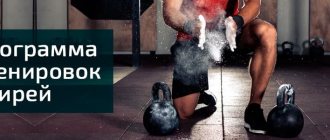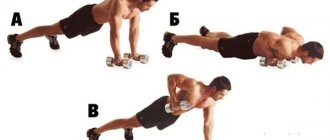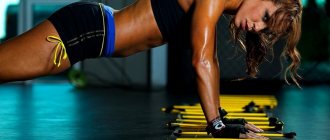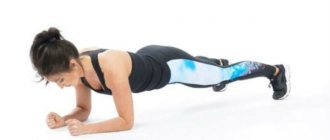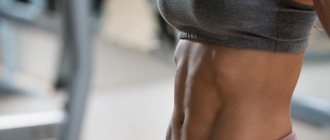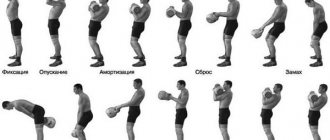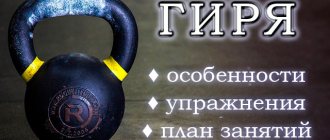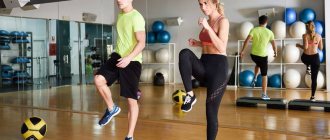Share:
What you need
- Weight
Swinging kettlebells with two hands is an exercise that came to CrossFit from kettlebell lifting. And if in kettlebell lifting the performance of this exercise is of an auxiliary nature for the development of strength and endurance in exercises such as the snatch and jerk of weights, then in functional training its purpose is somewhat different.
Swinging kettlebells with two hands is a basic exercise that involves almost all muscle groups, increases the explosive strength of the legs and shoulder girdle, and when combined with other basic exercises within one complex, contributes to a tremendous increase in strength endurance.
Today we will discuss the following points:
- Why is it used?
- What muscle groups does this exercise work?
- Technique for performing the exercise and errors that occur during execution.
- The benefits of this exercise.
- CrossFit complexes, which include two-handed kettlebell swings.
What is this exercise for?
The kettlebell is a great tool for the true CrossFit athlete and can take your workouts to the next level of intensity. One of the exercises that we highly recommend including in your arsenal is the two-handed kettlebell swing. This is a relatively simple exercise from the point of view of proper technique, and is definitely suitable for those athletes who are just starting to get acquainted with such a discipline as CrossFit. With this exercise, you will develop good explosiveness in the hips and glutes, which will be a huge plus as your fitness level increases and you begin to perform exercises such as sumo deadlifts, front squats and barbell jerks with decent weights.
What muscle groups are used by two-handed kettlebell swings? The main work is done by the quadriceps, hamstrings and gluteal muscles, as well as the lumbar back. The movement is explosive in nature, most of the amplitude of the kettlebell passes through inertia, and only the last 20-30% of the amplitude of the projectile passes through the force of the deltoid muscles, especially the anterior fascicle. The abdominal press and spinal extensors are in static tension throughout the entire exercise. Also, two-handed kettlebell swings develop grip strength well if you perform the exercise with a kettlebell weighing 24 kg or more. This will definitely benefit your hands and forearms; a handshake of steel is guaranteed.
Top 10 strength exercises with kettlebells
Kettlebells are an amazing piece of equipment for home workouts that are suitable for any athlete who values quality strength training. Perform the exercises for the specified number of repetitions or train on a timer, as recommended above.
Kettlebell Squats
How to do it : To begin, firmly grasp the handle of the kettlebell on both sides and lift the weight toward your chest. Place your feet in line with your shoulders, straighten your back, slightly bend your lower back, and direct your gaze clearly in front of you. Now perform a low squat, holding the weight statically in your hands. Lower yourself until your thighs are parallel to the floor, pause for a second in the lower position and return back.
Benefits of the exercise : This is an excellent alternative to classic squats, aimed at increasing the muscle mass of the legs, as well as developing their physical parameters. The muscles of the thighs and buttocks are qualitatively worked out, the static strength of the arms is developed, and the hand grip is strengthened.
How much to do : 10-12 repetitions.
Deadlift with kettlebell
How to do it : Place the projectile in front of you and come almost close to it. Next, place your feet wider than your shoulders, tilt your upper body, and grab the handle of the weights with both hands. Bend your back with your lower back, slightly bend your legs at the knee joint, and direct your gaze clearly in front of you. Next, lift the weight with the strength of your back muscles, straightening into a vertical position.
Benefits of the exercise : This element of training with a weight at home perfectly works the muscles of the lower back, paravertebral columns, hamstrings, and buttocks. Deadlift strengthens the hand grip and also contributes to the development of the athlete’s overall strength.
How much to do : 10-12 repetitions.
Throwing a weight
How to perform : Feet should be placed slightly wider than the shoulder line. Bend your legs slightly at the knees, grab the handle of the projectile. Next, swing the weight between your legs by your heels, then forcefully “throw” your arm up to bring the weight to your shoulder. After this, lower the projectile back, dropping the weight by pushing your shoulder and back. Keep your back straight throughout the entire amplitude, watch for a “kink” in the hand (there should not be one). The exercise is performed first on one hand, then on the other.
Benefits of the exercise : This is an effective way to pump up the biceps, shoulders, forearm and hand muscles, as well as the back muscles. One of the classic kettlebell exercises for developing the upper body.
How much to do : 10-12 repetitions, first on one side, then on the other side.
Bent-over kettlebell row for back
How to do it : Spread your legs wider than your shoulders, bend your knees slightly. Take a step back with your left foot and place it on your toes. Grasp the kettlebell with your left hand and place your right hand on your right thigh to achieve better balance as you perform. Your task is to pull the weight to your belt using the strength of the latissimus muscle. After completing the required number of repetitions, the hand changes.
Benefits of the exercise : An element of training with a kettlebell at home will help develop the volume of the latissimus muscle, giving the back the aesthetic shape of an inverted triangle. The process also uses the rear deltoids, which are necessary to develop impressive shoulder width.
How much to do : 10-12 repetitions, first on one side, then on the other side.
Sumo squat + biceps curl
How to do it : Wrap your palms tightly around the kettlebell and lift it toward your chest. After this, stand in a stance with your feet wide apart, toes pointed out. From this position, perform a sumo squat until your thighs are parallel to the floor. At the bottom, extend your arms, lowering the weight toward the ground, and lift it back up, relying solely on the strength of your biceps. After that, get up and start a new repetition. Stick to an average pace.
Benefits of the exercise : This strength exercise with a kettlebell loads both arms and legs at the same time, making it optimal for complex strength training of the whole body and fat burning. It also increases the overall endurance of the athlete due to the same development of several muscle groups.
How much to do : 10-12 repetitions.
Standing kettlebell press
How to do it : Grab a kettlebell with one hand, bend your arm and lift the barbell to chin level. Begin to forcefully push the weight upward without allowing the elbow joint lock to fully engage. The work is carried out using the strength of the deltoid muscles. After completing the desired number of repetitions, switch hands.
Benefits of the exercise : Strength exercise with a kettlebell is one of the most effective for gaining muscle mass in the shoulders. It has a simple principle of execution, but beginners are recommended to start with small weights. When lifting weights, try not to rely on body inertia and avoid unnecessary body movements.
How much to do : 10-12 repetitions, first on one side, then on the other side.
Swing with change of hands
How to do it : Start by lifting the weight with one arm, then assume a standard stance with your feet wide apart. Next, you need to swing the weight, passing it between your legs, for the subsequent swing in front of you. When the hand with the apparatus is parallel to the floor, grab the weight with your other hand. At the lowest point, swinging is done again with the entire subsequent amplitude of movement.
Benefits of the exercise : Swing allows you to develop tremendous strength in your shoulder muscles. You will also learn how to competently use the functionality of the back of the thigh, accordingly, strengthening this area. The exercise also perfectly works the muscles of the buttocks and torso, helping to burn subcutaneous fat.
How much to perform : 10-12 repetitions on each side.
Lying triceps extension
How to do it : Lie on your back on a gymnastics mat, bend your legs, and then place them on your full feet. Now grab the kettlebell behind your head by the handle with both hands. Gently lift it above you, and then perform arm curls, maintaining a static perpendicular position of the shoulder to the floor. In the process of flexion and extension, focus on the work of the triceps.
Benefits of the exercise : The kettlebell element of the workout is great for working the back of the arms. Triceps become stronger, fuller and more defined. To begin with, try to work with light weights to get used to the new load.
How much to do : 10-12 repetitions.
Kettlebell row while lying down
How to perform : The exercise begins with a prone position (plank) with outstretched arms. Place a kettlebell nearby first because the next step is to lift the weight with one hand. Keeping your body weight in the starting position, begin to pull the bar up to chest level, relying solely on the strength of your latissimus dorsi muscle.
Benefits of the exercise : This exercise is intended not only to develop the volume of the latissimus muscles, but also to strengthen the entire body as a whole. The element combines a static load on the whole body and an insulating load, which will help to achieve an impressive shield-shaped back. The exercise also helps strengthen your abs.
How much to do : 10-12 repetitions, first on one side, then on the other side.
Body twists with a kettlebell
How to do it : Sit on a gymnastics mat and take a dumbbell, holding it tightly with both hands near your waist. Now you need to move your body back and lift your legs off the floor, keeping balance on your buttocks. Start making turns to the right and left, focusing on the work of the abdominal muscles.
Benefits of the exercise : Strength exercise with a kettlebell allows you to achieve sculpted abs and tighten your abs. This is an extremely effective exercise for people who want to get rid of excess fat in the problematic waist area. It also develops static strength of the abdominal muscles due to constant load.
How much to perform : 10-12 repetitions on each side.
Ready-made training plans for men:
- Ready-made strength program for 7 days with dumbbells
- Ready-made program for losing belly fat without equipment (for 3 days)
- Ready-made split training program with dumbbells (3 days)
- Ready-made workouts for body tone without equipment (for 3 days)
Execution technique
So we got to the most important thing - the technique of swinging kettlebells with two hands. Let's look at this exercise down to its core, starting from the starting position and ending with its highest point.
Starting position
Traditionally, let's start from the starting position:
- Feet slightly wider than shoulder width.
- Toes are placed apart at 45 degrees.
- Feet pressed firmly to the floor.
- The center of gravity lies on the heels.
- The pelvis is laid back, the back is perfectly straight.
- We do not tilt our heads down and do not bend our necks back; our gaze should be directed strictly in front of us. The kettlebell stands on the floor between your legs.
Correct execution of the movement
We lift the weight off the floor and make a small swing back towards the gluteal muscles. A slight tilt of the body forward is allowed, but the back must remain straight throughout the entire movement; rounding it is unacceptable.
As the weight begins to fall by inertia, we make a powerful effort with our legs and gluteal muscles. The knee joint straightens, the pelvis moves forward. We shift the center of gravity from the heels to the middle of the foot. The movement should be powerful and fast, but not abrupt; it is important to understand the biomechanics of the movement; for this, it is recommended to start performing this exercise with a light weight for a large number of repetitions.
If the movement is performed correctly, the kettlebell should “fly” in front of you. Usually the inertial force is enough until the weight reaches the level of the solar plexus, then you should engage the front deltoids and bring the weight to the level of your shoulders or chin. From this position, the apparatus is lowered down to approximately knee height, placed slightly behind the heels, and another repetition is performed.
Alternate reverse lunges with kettlebell rotation
In the starting position, grab the inverted kettlebell by the horns. Step back with your left foot into a reverse lunge position. Touch your knee to the ground, return to the starting position and rotate the kettlebell counterclockwise. Repeat the movement with your right leg, turning the weight clockwise. This is one repetition, you need to do ten such repetitions.
Common mistakes
Next, we will look at the most common mistakes when performing two-handed kettlebell swings.
- The amplitude of the movement does not imply lifting the weight above the head, since such a vector of movement is anatomically inconvenient for the shoulder joint and ligaments. The correct option for performing the exercise is to bring the weight to the level of the shoulder girdle or chin.
- It is not recommended to relax the buttocks at the top point, otherwise the lowering of the projectile down will be more abrupt, and control over the movement will be lost.
- Do not lift your heels off the floor while performing the exercise. This will entail a loss of control over movement, the heavy weight will begin to “outweigh” you, and your back will round, which can lead to injury.
- Do not start the exercise if you are experiencing pain or discomfort in the lumbar spine or shoulders. Wait for complete recovery, otherwise the situation can easily worsen, and the recovery process can take up to several months.
- Do not start the exercise without warming up properly. Pay special attention to the lumbar and cervical spine, knee and shoulder joints.
- Perform the exercise in loose, non-tight clothing. Due to the fact that the movement itself is quite fast and explosive, the seams on your pants or shorts can easily come apart. It would seem nonsense, but who wants to walk around the gym in torn clothes?
Key Benefits of Kettlebell Training
Why is the kettlebell so good and what are the main advantages of using it in strength training?
The fact is that the weight's center of gravity is shifted when working with it. This allows you not only to work the muscles in completely different planes and perform exercises characteristic only of this apparatus, but also to load numerous stabilizer muscles. A similar effect is almost impossible to achieve by performing the same exercises with ordinary dumbbells.
As for kettlebell lifting, in our time it consists of 2 disciplines:
- Classic double-event, consisting of a kettlebell snatch with one hand and a push of two kettlebells from the chest with both hands.
- Push the weights through a full cycle (with lowering between the legs).
Chest push technique:
Snatch technique:
Long cycle kettlebell pushing technique:
There is a standard (competition gradation of weights by weight): 16 kg (1 pood), 24 kg (1.5 poods), 32 kg (2 poods), but for training you can also use weights with intermediate weights.
Each exercise at the competition is given 10 minutes to complete, during which you must complete as many repetitions as possible.
Performing these exercises not only loads almost the entire body of the athlete, but also significantly develops strength endurance, explosive power, cardiovascular system, as well as serious willpower, since doing a few more repetitions in the last minutes when the whole body is completely tired is very difficult. Therefore, the main emphasis in training athletes is on developing the functional capabilities of the body.
The most important muscle groups for kettlebell lifting:
- legs (quadriceps, calves);
- back (extensors);
- shoulder girdle.
Benefits of exercise
Two-handed kettlebell swings are a useful multifunctional exercise that is simultaneously responsible for explosive leg strength, maintaining static tension in the core muscles, and developing strength endurance and grip strength. For these reasons, this exercise has gained enormous popularity not only in CrossFit and kettlebell lifting, but also in mixed martial arts, Brazilian jiu-jitsu, grappling and other types of martial arts. Some athletes who are interested in fitness and bodybuilding also include this exercise in their training program, which leads to increased strength in such common exercises as classic and front squats with a barbell, deadlifts, military presses, shrugs and others. Therefore, the benefits of kettlebell swings cannot be overestimated.
Recipes for healthy eating
Beef meatballs in tomato sauce
- 9.9 g Protein
- 10.1 g Fat
- 25.9 g Carbohydrates
- 209.8 kcal
30-40 min.
- #second course
- #milk
- #carrot
- #dinner
- #breadcrumbs
- #parsley
- #vegetable oil
- #onion
- #spices
- #meatballs
- #tomato sauce
- #dinner
- #ground meat
- #garlic
Other recipes
Explosive Jumping Deadlift
Stand straight, feet shoulder-width apart, weights between your legs. Squat down and grab a kettlebell, then perform an explosive deadlift by jumping as high as you can at the top of the range. Slowly lower the bar and reset for the second rep. Do 10 repetitions.
Standards for the kettlebell push
The kettlebell push is a competitive exercise in kettlebell lifting. The following are tables of grade standards for men and women for 2018-2021.
TABLE OF DISCHARGE STANDARDS FOR MEN: DC push (number of weight lifts in 10 minutes)
| Weight category (kilogram) | MSMK kettlebell 32kg | MS kettlebell 32kg | KMS kettlebell 32kg | I weight 24kg | II kettlebell 24kg | III kettlebell 24kg | I(u) kettlebell 16kg | II(u) kettlebell 16kg | III(u) kettlebell 16kg |
| 48 | — | — | — | — | — | — | 40 | 35 | 30 |
| 53 | — | — | — | — | — | — | 48 | 42 | 36 |
| 58 | — | — | — | 55 | 45 | 35 | 55 | 48 | 40 |
| 63 | 59 | 44 | 35 | 60 | 49 | 39 | 61 | 51 | 42 |
| 68 | 72 | 56 | 45 | 65 | 54 | 43 | 66 | 56 | 46 |
| 73 | 76 | 62 | 48 | 70 | 58 | 46 | 71 | 61 | 51 |
| 73+ | — | — | — | — | — | — | 74 | 64 | 54 |
| 78 | — | — | — | 74 | 62 | 50 | — | — | — |
| 85 | 82 | 69 | 55 | 79 | 66 | 54 | — | — | — |
| 85+ | 88 | 75 | 58 | 90 | 75 | 60 | — | — | — |
TABLE OF DISCHARGE STANDARDS FOR WOMEN: DC push (number of weight lifts in 10 minutes)
| Weight category (kilogram) | MSMK kettlebell 24kg | MS kettlebell 24kg | KMS kettlebell 24kg | I weight 16kg | II kettlebell 16kg | III kettlebell 16kg |
| 63 | 59 | 44 | 35 | 60 | 49 | 39 |
| 63+ | 72 | 56 | 45 | 65 | 54 | 43 |
CONVENTIONAL ABBREVIATIONS: MSMK - master of sports of international class MS - master of sports KMS - candidate master of sports I - first category II - second category III - third category I (u) - first youth category II (u) - second youth category III (u ) - third youth category
Muscles involved in the exercise
Let's look at what muscles work when performing a kettlebell push with one hand. During the kettlebell push, a large number of different muscle groups work, the main load falls on the deltoid and trapezius muscles. The triceps, biceps, forearm, quadriceps, gluteal muscles, upper back, and core muscles (lumbar muscles and abs) play a supporting role.
Some muscles work more, some less, which, in particular, depends on the technique of performing the push, but, nevertheless, the push allows you to work almost the entire body. It is especially important to practice coordination of movements, their synchronization and sequence, so as not to get confused and not cause injury to yourself.
Important! When performing the exercise, the hand must be strictly fixed to avoid injury.
Complex training
The exercise can be used both in training the arms and shoulders, and in training the back or in “fulbadi” (full body training). In this paragraph we will give an example of a workout that involves pushing a kettlebell with one hand.
300 Spartans
Task: complete the following exercises as quickly as possible without stopping. 25 pull-ups; 50 deadlifts 60kg; 50 push-ups; 50 jumps on a pedestal 60-75cm; 50 polishers (touch both sides = 1 time); Take 50 pushes of a weight (dumbbell) from the floor. 24/16 kg (25+25); 25 pull-ups.
Important points
To ensure that your training brings only positive results, pay attention to a few simple recommendations:
- Do not allow your wrist to bend or straighten while doing presses. Your wrist is in line with your forearm - this is a necessary condition for the safety of the ligaments and joint.
- Keep your entire body tense as you move. There should be no relaxation in the legs, buttocks or body.
- Don't be fanatic about choosing the weight of the weights. A machine that is too heavy will prevent you from performing the exercise correctly and create a risk of injury. The market offers a huge number of options for dumbbells - for any color and size. Remember that a 32 kg kettlebell press can be done by a trained athlete, but not by a beginner who has not previously engaged in strength sports.
- Pay attention not only to strength exercises, but also to stretching. It will make the muscles and ligaments more elastic, the movements will become cleaner, and the technique will be much easier to master.
- In this exercise, try to avoid jerking. Raise the projectile under control and lower it under control.
Even if you have previously trained your shoulders with dumbbells or a barbell, adding kettlebell lifts to your program will create an unusual load on the muscles, thereby creating an impulse for their growth and increase in strength.
